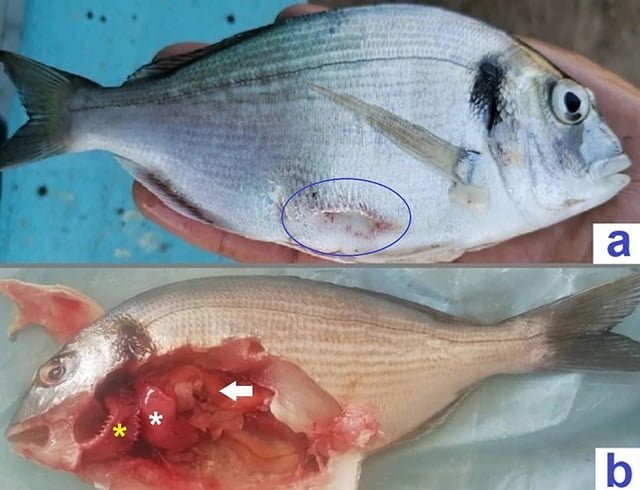
Gilthead seabream (Sparus aurata) fish farmers have faced significant losses due to a mysterious disease. A recent scientific study has shed light on the cause of a concerning trend in gilthead seabream aquaculture: high mortality rates in farmed gilthead seabream (Sparus aurata). The culprit? A bacterium called Pseudomonas putida.
A research, conducted by a team of experts from the National Institute of Oceanography and Fisheries, NIOF (Egypt), and the Agricultural Research Center (Egypt), isolated and identified the pathogen Pseudomonas putida responsible for mass mortality in gilthead seabream (S. aurata). Furthermore, the researchers determined the suitability of florfenicol as an effective treatment for S. aurata against P. putida infection.
The double-edged sword of discard fish
Discard fish holds no commercial value as it is not used in human consumption. Discard fish is either accidentally caught or collected post-harvest of fish that have reached commercial size. A common practice among marine fish farmers is to use discard fish to feed their fish.
Key characteristics of discard fish include:
- Economic advantage: Discard fish is a more economical alternative to formulated feed, making it appealing to fish farmers.
- Health risks: This study reveals that discarded fish can harbor harmful bacteria, such as Pseudomonas putida, leading to disease outbreaks in cultured fish.
Symptoms and identification
Researchers identified the culprit as Pseudomonas putida, a bacterium present in discard fish: tilapias, used in feeding gilthead seabream. This bacterium was isolated from both diseased fish and feed, confirming its role in the disease.
Infected fish exhibited external signs such as skin hemorrhages and ulcerations. Upon analyzing bacterial isolates and their 16S rRNA gene sequence, scientists confirmed the presence of P. putida.
Further investigation revealed that all P. putida isolates formed biofilms, making them more challenging for the fish’s immune system to combat. Additionally, over 60% of isolates were capable of lysing (breaking down) red blood cells, which could contribute to observed hemorrhages.
It’s important to note that P. putida is characterized by:
- This bacterium is widespread in aquatic environments and can be found in fish ponds.
- It has previously been associated with diseases in other fish species, highlighting its potential as a severe pathogen in aquaculture.
Treatment potential
The study explored the efficacy of florfenicol, a broad-spectrum antibiotic, in combating P. putida infection in gilthead seabream. Florfenicol acts by inhibiting bacterial protein synthesis, effectively halting the pathogen.
The good news is that P. putida showed sensitivity to the antibiotic florfenicol. Tests revealed minimum inhibitory concentrations (MICs) ranging from 0.25 to 1.0 µg ml-1, indicating efficacy at these levels. The concerning aspect is that bacteria were resistant to commonly used antibiotics such as ampicillin and sulfamethoxazole-trimethoprim.
Florfenicol efficacy
A pathogenicity test confirmed the detrimental effects of P. putida on gilthead seabream. However, treatment with florfenicol offered significant protection. Fish receiving 20 mg kg-1 of florfenicol in their feed showed no mortality after being exposed to the bacteria. Even with a lower dose of 10 mg kg-1, mortality was significantly reduced compared to untreated fish. Additionally, serum analysis of fish confirmed the presence of effective levels of florfenicol post-treatment.
Conclusion
This study successfully identified P. putida as the cause of high mortality in cultured gilthead seabream. Administration of florfenicol in feed at 20 mg kg-1 proved to be an effective treatment strategy.
These findings offer valuable guidance for gilthead seabream breeders. Implementing routine screening tests for P. putida and considering the use of florfenicol as treatment, with proper veterinary guidance, can significantly reduce fish loss and ensure a healthy harvest.
While this study highlights the efficacy of florfenicol, it’s crucial to practice responsible antibiotic use in aquaculture to prevent long-term antibiotic resistance development. Exploring alternative preventive measures, such as improving feed hygiene and selective breeding for disease resistance, can also contribute to sustainable gilthead seabream farming.
Funding for open access to the article was provided by the Science, Technology & Innovation Funding Authority (STDF) in cooperation with the Egyptian Knowledge Bank (EKB).
Contact
Nadia G. Ali
National Institute of Oceanography and Fisheries, NIOF, Cairo, Egypt
Email: ng.ali@niof.sci.eg
Reference (open access)
Aboyadak, I.M., Abdel-Tawwab, M. & Ali, N.G. Identification and florfenicol-treatment of pseudomonas putida infection in gilthead seabream (Sparus aurata) fed on tilapia-trash-feed. BMC Vet Res 20, 156 (2024). https://doi.org/10.1186/s12917-024-04004-z

